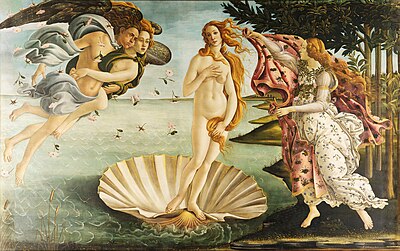Triumph of Neptune and Amphitrite

The Triumph of Neptune and Amphitrite (or Birth of Venus) by
putti
flying over their heads.
This mythological scene clearly depicts
It seems that the oldest recorded title is il trionfo di Nettunno by Giovanni Pietro Bellori (d. 1698). The matter was the subject of considerable scholarly debate in the 1960s, and Anthony Blunt concluded that Poussin was working on ideas for all these subjects, and the painting "bears the marks of the other subjects, though it represents Neptune and Amphitrite".[2]
Triumph of Galatea, 1512, fresco

The depiction is somewhat similar to the
Poussin would certainly have known the Raphael from prints, and probably saw the original, which was in the
Medici family country house near Florence
, was then far less famous and less accessible.
The painting was painted for
See also
Notes
References
- France in the Golden Age: Seventeenth-century French Paintings in American Collections, Pierre Rosenberg, Sir John Wyndham Pope-Hennessy, Marc Fumaroli, Metropolitan Museum of Art (New York, N.Y.), 1982, online
Wikimedia Commons has media related to Le Triomphe de Neptune - Nicolas Poussin - Philadelphia Museum of Art.
